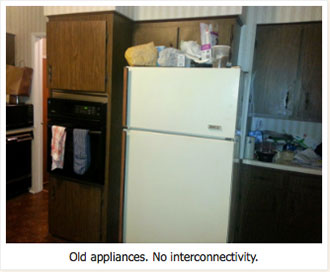
The answer to the appliance question was, for the kitchen, an easy one; there’s no synergy at all between a refrigerator, a stove and a dishwasher. A single-source would perhaps give a slightly more consistent look, but that’s it. Instead I’d look at each item on its own and choose the best fit for our use profile and budget.
“Single source” versus “best in breed” is a question that frequently arises around technology, and one which not many years ago I’d have approached the same way I approach appliances today. I especially remember analog systems that might use video switchers, videoconferencing appliances and control systems all from different manufacturers. In a large build gear might not even be consistent from room to room; I’ve seen, for example, one manufacturer’s touchscreens in specialty spaces and another’s keypad controller in a simpler rooms. With purely standalone systems, it made sense to choose best in breed rather than a single source. As a consultant, I’d need (amongst other knowledge) broad familiarity with the product offerings of many vendors and and understanding of their strengths and weaknesses.
Is this still the case? I find it telling that when I told one of my colleagues at SMW that single-source didn’t make sense for my kitchen because the appliances don’t talk to each other he corrected me: They don’t talk to each other YET, but they almost certainly will. It’s easy to imagine a home full of smart appliances coordinating, for example, energy and water usage so as not to overload the infrastructure at peak times. It’s quite likely that my next set of kitchen appliances (a long time from now, I’m hoping) will be a single-manufacturer ecosystem.
Does this mean that the AV designers role is fading? After all, if one is going to deploy a single-source solution it’s quite easy to get a master quote from one or more vendors listing all of the pieces and parts it would take to make the solution work. I’d say that this can’t be farther from the truth, and the consultant is every bit as important. First, we still need to do the same work in evaluating client needs, in project programming, and in coordinating all of the moving parts it takes to get from the idea of needing AV solutions to the actuality of having working solutions. That part can’t be sources to a vendor if one wants independent, unbiased analysis.
Another thing to remember is the value of form as well as function and communicating with clients about how people work and how they want things to look. This goes to the kitchen table which at least three people have suggested to me. We generally don’t eat in the kitchen, but do quite a bit of cooking. As you can see, it isn’t all that large a space. While adding a table would increase workspace, it would do so at the expense of cluttering the area and cutting travel between, say, the microwave and the sink. It’s a bad tradeoff for the same reason a gooseneck mic on a conference table is often a bad tradeoff. In both cases, there might be a narrow functional improvement which, to the user, is not worth as much as the tradeoff in aesthetics or workflow that will come with it.
The work we save by using single vendors — if we save anything — is what I’d argue is the least important in terms of design. It’s the detailed bits and pieces which make the vision work after it’s been conceived. While this is absolutely vital, it doesn’t speak to our core purpose in the design realm. In my years in the industry, I’ve seen clients having various levels of satisfaction with the end results of AV projects. Those who were less than fully satisfied almost never had functionality complaints; AV contractors are very good at delivering systems which, at the end of the day, work. The user hits the button, the projector lights up, an image appears on the screen. The bigger problems are almost always ones of expectations; the projects which fail have often failed when someone didn’t ask the right question, months or even years before anyone has chosen the nuts and bolts needed to execute what would eventually be a flawed vision.
The role of the AV consultant (and designers as a whole) might be evolving even farther from a focus on “nuts and bolts,” but the core of what we do — helping clients find a vision and marrying that vision to available technology — hasn’t changed.